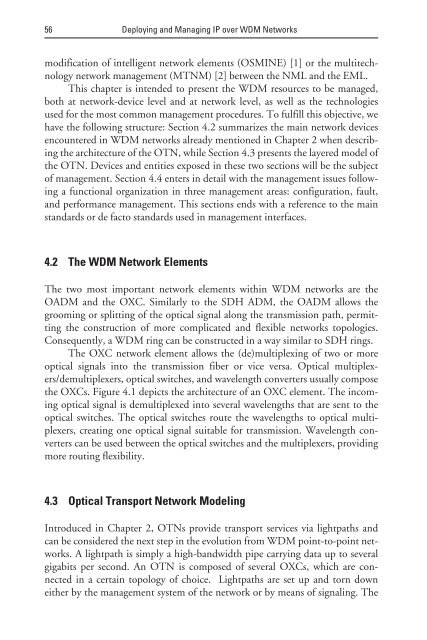deploying and managing ip over wdm networks - Index of
deploying and managing ip over wdm networks - Index of
deploying and managing ip over wdm networks - Index of
You also want an ePaper? Increase the reach of your titles
YUMPU automatically turns print PDFs into web optimized ePapers that Google loves.
56 Deploying <strong>and</strong> Managing IP <strong>over</strong> WDM Networks<br />
modification <strong>of</strong> intelligent network elements (OSMINE) [1] or the multitechnology<br />
network management (MTNM) [2] between the NML <strong>and</strong> the EML.<br />
This chapter is intended to present the WDM resources to be managed,<br />
both at network-device level <strong>and</strong> at network level, as well as the technologies<br />
used for the most common management procedures. To fulfill this objective, we<br />
have the following structure: Section 4.2 summarizes the main network devices<br />
encountered in WDM <strong>networks</strong> already mentioned in Chapter 2 when describing<br />
the architecture <strong>of</strong> the OTN, while Section 4.3 presents the layered model <strong>of</strong><br />
the OTN. Devices <strong>and</strong> entities exposed in these two sections will be the subject<br />
<strong>of</strong> management. Section 4.4 enters in detail with the management issues following<br />
a functional organization in three management areas: configuration, fault,<br />
<strong>and</strong> performance management. This sections ends with a reference to the main<br />
st<strong>and</strong>ards or de facto st<strong>and</strong>ards used in management interfaces.<br />
4.2 The WDM Network Elements<br />
The two most important network elements within WDM <strong>networks</strong> are the<br />
OADM <strong>and</strong> the OXC. Similarly to the SDH ADM, the OADM allows the<br />
grooming or splitting <strong>of</strong> the optical signal along the transmission path, permitting<br />
the construction <strong>of</strong> more complicated <strong>and</strong> flexible <strong>networks</strong> topologies.<br />
Consequently, a WDM ring can be constructed in a way similar to SDH rings.<br />
The OXC network element allows the (de)mult<strong>ip</strong>lexing <strong>of</strong> two or more<br />
optical signals into the transmission fiber or vice versa. Optical mult<strong>ip</strong>lexers/demult<strong>ip</strong>lexers,<br />
optical switches, <strong>and</strong> wavelength converters usually compose<br />
the OXCs. Figure 4.1 depicts the architecture <strong>of</strong> an OXC element. The incoming<br />
optical signal is demult<strong>ip</strong>lexed into several wavelengths that are sent to the<br />
optical switches. The optical switches route the wavelengths to optical mult<strong>ip</strong>lexers,<br />
creating one optical signal suitable for transmission. Wavelength converters<br />
can be used between the optical switches <strong>and</strong> the mult<strong>ip</strong>lexers, providing<br />
more routing flexibility.<br />
4.3 Optical Transport Network Modeling<br />
Introduced in Chapter 2, OTNs provide transport services via lightpaths <strong>and</strong><br />
can be considered the next step in the evolution from WDM point-to-point <strong>networks</strong>.<br />
A lightpath is simply a high-b<strong>and</strong>width p<strong>ip</strong>e carrying data up to several<br />
gigabits per second. An OTN is composed <strong>of</strong> several OXCs, which are connected<br />
in a certain topology <strong>of</strong> choice. Lightpaths are set up <strong>and</strong> torn down<br />
either by the management system <strong>of</strong> the network or by means <strong>of</strong> signaling. The


